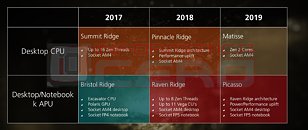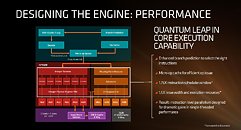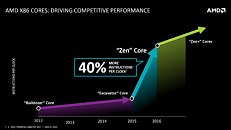Tuesday, September 26th 2017

AMD Zen 2 Architecture: Socket AM4, 2019, Code-named "Matisse"
AMD's Zen-based Ryzen and Threadripper have been said by the company as representing the "worst case scenario" of performance for their architecture. This is based on the fact that there are clear areas for improvement that AMD's engineers were keenly aware of even at the moment of Zen's tapping-out; inadvertently, some features or improvements were left on the chopping block due to time and budget constraints. As unfortunate as this is - who wouldn't love to have even more performance on their AMD processors - this also means AMD has a clear starting point in terms of improving performance of their Zen micro-architecture.
Spanish website Informatica Cero have gotten their hands on what they say is an exclusive, real piece of information from inside AMD, which shows the company's CPU roadmap until 2019, bringing some new details with it. On the desktop side, there's mention of AMD's "Pinacle Ridge" as succeeding the current Zen-based "Summit Ridge" Ryzen CPUs in 2018. These leverage the same Summit Ridge architecture, but with a performance uplift; this plays well into those reports of 12 nm being used to manufacture the second-generation Ryzen: it's an AMD tick, so to say. As such, the performance uplift likely comes from increased frequencies at the same power envelope, due to 12 nm's denser manufacturing design.Another interesting tidbit from this slide is the confirmation of AMD's Zen 2 processors being released in 2019. Based on the company's revised Zen 2 cores (which should see those architectural improvements we were talking about in the beginning of this piece), AMD also seems to be doing away with the ridge-like codenames they've been using in recent times, and taking a more artistic approach. Matisse seems to be the code-name for AMD's Zen 2 architecture, and if you know your painters, it looks like AMD is betting on its Zen 2 cores to further define and influence CPU design. There is no mention of increased Zen threads, however, which likely points towards AMD keeping the same 8-core, 16-thread design as with their current Summit Ridge. This likely plays into AMD's plan for keeping the AM4 socket relevant - while good for consumers who might want to see longevity in their platform, it does prevent AMD from making more radical design changes to their architecture.Jumping towards its notebook/desktop APU designs, AMD is looking to accompany Matisse with their code-named Picasso APUs for 2019. These should still leverage the company's upcoming Raven Ridge line of APUs, which pair Vega 11 NCUs on the graphical side of the equation and up to 8 Zen threads (4-core CPUs with SMT). However, usage of 12 nm processes across both its Zen CPU cores and Vega 11 NCUs apparently give AMD confidence that they can improve Picasso over Raven Ridge not only in the performance fields, but also the power consumption metrics.
A little bit of lore: AMD seems to be changing their code-names towards painters, and the marriage of Matisse in the CPU and Picasso in the APU space isn't a coincidence. Both artists are considered two of the most important players in the arts space of the beginning of the twentieth century, responsible for both defining and developing the arts. AMD's choice of both of them is, therefore, not a fluke; it's likely more of an artistic take on the company's vision of further defining itself as a key innovative player in the CPU space.
Sources:
Informatica Cero, Pablo Picasso @ Wikipedia, Henri Matisse @ Wikipedia
Spanish website Informatica Cero have gotten their hands on what they say is an exclusive, real piece of information from inside AMD, which shows the company's CPU roadmap until 2019, bringing some new details with it. On the desktop side, there's mention of AMD's "Pinacle Ridge" as succeeding the current Zen-based "Summit Ridge" Ryzen CPUs in 2018. These leverage the same Summit Ridge architecture, but with a performance uplift; this plays well into those reports of 12 nm being used to manufacture the second-generation Ryzen: it's an AMD tick, so to say. As such, the performance uplift likely comes from increased frequencies at the same power envelope, due to 12 nm's denser manufacturing design.Another interesting tidbit from this slide is the confirmation of AMD's Zen 2 processors being released in 2019. Based on the company's revised Zen 2 cores (which should see those architectural improvements we were talking about in the beginning of this piece), AMD also seems to be doing away with the ridge-like codenames they've been using in recent times, and taking a more artistic approach. Matisse seems to be the code-name for AMD's Zen 2 architecture, and if you know your painters, it looks like AMD is betting on its Zen 2 cores to further define and influence CPU design. There is no mention of increased Zen threads, however, which likely points towards AMD keeping the same 8-core, 16-thread design as with their current Summit Ridge. This likely plays into AMD's plan for keeping the AM4 socket relevant - while good for consumers who might want to see longevity in their platform, it does prevent AMD from making more radical design changes to their architecture.Jumping towards its notebook/desktop APU designs, AMD is looking to accompany Matisse with their code-named Picasso APUs for 2019. These should still leverage the company's upcoming Raven Ridge line of APUs, which pair Vega 11 NCUs on the graphical side of the equation and up to 8 Zen threads (4-core CPUs with SMT). However, usage of 12 nm processes across both its Zen CPU cores and Vega 11 NCUs apparently give AMD confidence that they can improve Picasso over Raven Ridge not only in the performance fields, but also the power consumption metrics.
A little bit of lore: AMD seems to be changing their code-names towards painters, and the marriage of Matisse in the CPU and Picasso in the APU space isn't a coincidence. Both artists are considered two of the most important players in the arts space of the beginning of the twentieth century, responsible for both defining and developing the arts. AMD's choice of both of them is, therefore, not a fluke; it's likely more of an artistic take on the company's vision of further defining itself as a key innovative player in the CPU space.







65 Comments on AMD Zen 2 Architecture: Socket AM4, 2019, Code-named "Matisse"
We've also seen Ryzen being OCed to 5GHz or beyond with extreme cooling. So at this point in time we don't know whether Zen is suited to 5GHz, on water, or that this is purely GF's process limitation. The z14 btw is on a different HP process.
actually we can predict to a point that new chips will be at least so fast as now clockwise and add 10-15% ipc improvement; tdp wise they shouldn't reach current one's but depend how good is this 12 nm process ...
just my 2c...
Once again OCing results are not guaranteed & when you say that it's highly disingenuous because KBL or SKLx aren't engineered to reach those clocks.
But what are we even talking about anymore ?
If it's OCed & yet isn't guaranteed to reach 5GHz, what do you call that?
I simply gave you an example of a series of CPUs built on a manufacturing process from 2010 , that can reach very high clock speeds , to make you understand that there are way more factors involved in this other than the node itself. Something you seem to not want to agree with , which is fine but this went on for far too long and now we're talking about things that have little to do with the original matter.
But then you insisted that Intel chips can be OCed to 5GHz, because they were meant to? This is not the case, unless we have different definitions of easy.
Ryzen does not and there is no guarantee it will do on an improved node, though somehow you are convinced it will.
You do realize how much of a oxymoron you're claims are ? You think Intel's chips reach 5 Ghz out of pure luck but somehow you are convinced Zen+ will hit 5 Ghz guaranteed based on no real evidence.
OK , let's wrap this up according to you :
- being a engineer at Intel must be a really easy job , you get insane speeds out the chips you designed in a consistent manner just by luck !
- all that matters is the node , but not just any node , only the ones developed with IBM
- Zen+ and 5 Ghz basically confirmed
Got it. Anything else ?
So let's see what changed between SKL & KBL :confused: maybe that'll answer your own theory?
Vya Domus, you can write r01ht till you are blue in the face and fingers sore and it will still argue for arrogance's sake. Easier to walk away from situations like this.
They'll probably tinker with Ryzen a bit to achieve slightly higher clocks, probably at slight expense of consumption which they'll compensate with a newer node. So, in general it should clock a bit higher, but not consume any more power. Which is exacty what you want for an upgrade.
I too believe that the LPP is holding Zen back.
It looks like you all got trolled into a pointless debate.